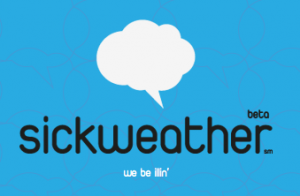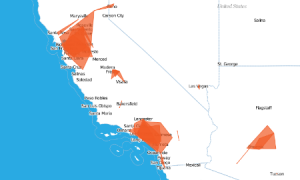Next time you are sick with the flu, make sure you tweet about it! By tweeting, you may be helping health professionals around the world track potential outbreaks. Social Media is a huge part of people’s lives and has become a societal norm. People are constantly updating their facebook statuses, or tweeting about everything they see or hear. Many people also get their news through their twitter timeline. There is a constant stream of information that is available on social networking sites. Now entrepreneurs and public health professionals are taking advantage of that information to track infectious diseases around the globe. For example, a new disease tracking website called sickweather.com has recently been unveiled. When people are sick, they may usually send a tweet out  to their followers saying “I am sick with the flu.” Often those posts contain location information. The website then uses that information and a special computer algorithm to track that data on a map. Alternately, individuals can also log into the website, and report any sickness. I really think this novel idea because it integrates social media in an such an innovative way in comparison to prior established disease tracking websites such as google flu trends and flunearyou.org.
to their followers saying “I am sick with the flu.” Often those posts contain location information. The website then uses that information and a special computer algorithm to track that data on a map. Alternately, individuals can also log into the website, and report any sickness. I really think this novel idea because it integrates social media in an such an innovative way in comparison to prior established disease tracking websites such as google flu trends and flunearyou.org.
In general, disease tracking websites are becoming more and more useful to government health agencies, hospitals, and healthcare providers. These websites can also help hospitals or health departments to prepare in advance if they see a potential outbreak. The websites also offer real, fast and accurate data compared to older methods used in disease surveillance. However, I think the current illness tracking websites are not used to their full potential. The best part of sickweather.com is that is not only focused on the flu like other websites. It tracks any type of infectious disease. Flunearyou.org and google flu trends are only focused on the flu. After flu season is officially over, these websites are not very useful for disease surveillance.
Google flu trends and flunearyou.org use different reporting mechanisms. Google flu trends only focus on google searches and flunearyou.org relies on people reporting directly on the website. The ways to  report or to track illness cases are quite limited through these websites. For instance, Google flu trends only record searches made from only google, not any other search engine. Also, the data that is tracked is quite general. Google flu data does not show a specific outbreak in a town, instead it shows a risk level in a larger location such as a state. Flunearyou.org represents cases by simple pinpoint by town and state.
report or to track illness cases are quite limited through these websites. For instance, Google flu trends only record searches made from only google, not any other search engine. Also, the data that is tracked is quite general. Google flu data does not show a specific outbreak in a town, instead it shows a risk level in a larger location such as a state. Flunearyou.org represents cases by simple pinpoint by town and state.
Sickweather.com is the first to intergrate and use social media to its full advantage. According to Online MBA, almost 68% of facebook users are over the age of 35. Similarly, 58% of twitter users are also over the age of 35. Infectious disease is more likely to affect individuals over the age of 35 because as people age, the risks of acquiring an infectious disease increase dramatically. The ability of the body to respond to vaccinations and medicines also falls with age. Since many people are over the age of 35 are majority users of social media, many more cases can be reported through social media than usual methods. It is also convenient as well. There is no extra effort needed by the consumer, except perhaps to allow the website to access his or her information. Also, sickweather.com shows detailed information of individual cases in a specific town, or even a street. Sickweather.com can also help search for potential illness based on the individual’s symptoms.
Sickweather.com has great potential to become a successful disease surveillance website. To make the website even better, sickweather.com can use a similar tracking techinque that google flu trends uses. They can get information from different search engines to track more cases. Many people who are sick, often use search engines to find more information about their illness. This method of surveillance can provide even additional data. Thus, tracking diseases can be more accurate and up to date. Sickweather.com does a great job at integrating social media into disease surveillance and creating real results. Overall, it is a very good health resource. Next time when you are sick, try using sickweather.com!


